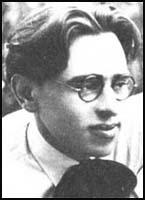Senya Fleshin

Senya Fleshin was born in Kiev, Russia, on 19th December, 1894. When he was sixteen his family emigrated to the United States and settled in New York City. He worked for the Mother Earth an anarchist journal published by Emma Goldman and Alexander Berkman.
In 1917 Fleshin returned to Russia to take part in the revolution. He worked for the Golos Truda, a journal edited by Vsevolod Volin in Petrograd. He was also a member of the the Nabat Confederation of Anarchist Organizations. He was soon in conflict with the Bolshevik government and when he wrote an article criticizing its policies he was arrested and imprisoned.
Soon after being released he met Molly Steimer, an anarchist who had been deported from the United States. On 1st November, 1922 Fleshin and Steimer was arrested and charged with aiding criminal elements in Russia. The following year they were deported to Germany where they joined Emma Goldman and Alexander Berkman in Berlin.
Fleshin and Molly Steimer moved to Paris and joined a group of anarchist exiles that included Nestor Makhno, Peter Arshinov, Vsevolod Volin, Emma Goldman, Alexander Berkman, Alexander Schapiro, Sébastien Faure, Jacques Doubinsky and Rudolf Rocker. They formed the Joint Committee for the Defense of Revolutionaries Imprisoned in Russia. In 1926 they established the Relief Fund of the International Working Men's Association for Anarchism and Anarcho-Syndicalists Imprisoned in Russia.
In 1926 Nestor Makhno joined forces broke with Peter Arshinov to publish their controversial Organizational Platform, which called for a General Union of Anarchists. This was opposed by Fleshin, Molly Steimer, Emma Goldman, Vsevolod Volin, Alexander Berkman, Sébastien Faure and Rudolf Rocker, who argued that the idea of a central committee clashed with the basic anarchist principle of local organisation. In November 1927 Steimer wrote: "The entire spirit of the platform is penetrated with the idea that the masses must be politically led during the revolution. There is where the evil starts."
Fleshin took up photography. As Paul Avrich has pointed out: "In order to earn a living, Senya had meanwhile taken up the profession of photography, for which he exhibited a remarkable talent; he became the Nadar of the anarchist movement, with his portraits of Berkman, Volin, and many other comrades, both well known and obscure, as well as a widely reproduced collage of the international anarchist press."
In 1929 Fleshin was invited to work in the studio of Sasha Stone in Berlin. Steimer went with him and they remained there until Adolf Hitler took power. They no longer felt safe in Nazi Germany and they moved back to Paris, where they remained until the Second World War. After the Nazi invasion and the formation of the Vichy government, Steimer and Fleshin decided to go to Mexico. They attempted to persuade Vsevolod Volin to go with them but he refused, claiming he had to stay in France in order to "prepare for the revolution when the war is over."
In Mexico City Steimer and Fleshin operated a successful photographic studio. They retired to Cuernavaca in 1963. Steimer died in 1980. As the of Anarchist Portraits (1995) has pointed out: "Senya, weak and ailing, was crushed by her sudden passing. Lingering on less than a year, he died in the Spanish Hospital in Mexico City on June 19, 1981."
Primary Sources
(1) Paul Avrich, Anarchist Portraits (1990)
For the next twenty years Senya operated his photographic studio in Mexico City under the name SEMO for Senya and Mollie. During this time they formed a close relationship with their Spanish comrades of the Tierra y Libertad group, while remaining on affectionate terms with Jack and Mary Abrams, notwithstanding Jack's friendship with Trotsky, who had joined the colony of exiles in Mexico. Shortly before his death in 1953, Abrams was allowed to enter the United States to have an operation for throat cancer. "He was a dying man who could hardly move," their friend Clara Larsen recalled, "yet he was guarded by an FBI agent twenty-four hours a day!"
Mollie, however, never returned to America. Friends and relatives had to cross the border and visit her in Mexico City or Cuernavaca, to which she and Senya retired in 1963. When deported from the United States, Mollie had vowed to "advocate my ideal, Anarchist Communism, in whatever country I shall be." In Russia, in Germany, in France, and now in Mexico, she remained faithful to her pledge. Fluent in Russian, Yiddish, English, German, French, and Spanish, she corresponded with comrades and kept up with the anarchist press around the world. She also received many visitors, including Rose Pesotta and Clara Larsen from New York.
In 1976 Mollie was filmed by a Dutch television crew working on a documentary about Emma Goldman, and in early 1980 she was filmed again by the Pacific Street Collective of New York, to whom she spoke of her beloved anarchism in glowing terms. In her last years, Mollie felt worn and tired. She was deeply saddened by the death of Mary Abrams in January 1978. Two years later, not long after her interview with Pacific Street films, she collapsed and died of heart failure in her Cuernavaca home. To the end, her revolutionary passion had burned with an undiminished flame. Senya, weak and ailing, was crushed by her sudden passing. Lingering on less than a year, he died in the Spanish Hospital in Mexico City on June 19, 1981.
